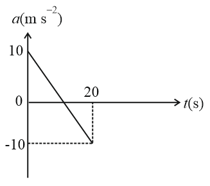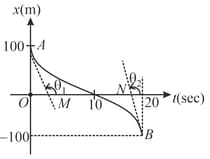MEDIUM
JEE Main/Advance
IMPORTANT
Earn 100
A body starts with an initial velocity of and moves along a straight line with a constant acceleration. When the velocity of the particle becomes the acceleration is reversed in direction without changing magnitude. Find the speed of the particle in when it reaches the starting point.
50% studentsanswered this correctly

Important Questions on Kinematics
HARD
JEE Main/Advance
IMPORTANT
Give value of
HARD
JEE Main/Advance
IMPORTANT
The acceleration time plot for a particle (starting from rest) moving on a straight line is shown in the figure. For given time interval,

MEDIUM
JEE Main/Advance
IMPORTANT
HARD
JEE Main/Advance
IMPORTANT
EASY
JEE Main/Advance
IMPORTANT
MEDIUM
JEE Main/Advance
IMPORTANT
A particle moves along the -axis and its -coordinate changes with time as .
MEDIUM
JEE Main/Advance
IMPORTANT
The graph below gives the coordinator of a particle travelling along the axis as a function of . is the tangent to the curve at the starting moment and is tangent at the end moment

The direction or of acceleration during the first seconds is
MEDIUM
JEE Main/Advance
IMPORTANT
